Thriving through a recession

In the midst of a crisis?
Thriving in the face of challenges
HRNZ Awards


In the midst of a crisis?
Thriving in the face of challenges
HRNZ Awards
Andrea Twaddle, Director, and Anna Jackman, Senior Associate, are both members of the Association of Workplace Investigations (AWI) and hold the globally recognised best practice AWI Certificate in Workplace Investigations.

They are sought after for their experience and skill in: Undertaking independent investigations, including allegations of bullying, harassment, and workplace stress.
• Providing training sessions and webinars on workplace investigations.
• Assistance and advice to in-house People and Culture teams about internal investigations. Contact Andrea or Anna with any queries: andrea@dtilawyers.co.nz | anna@dtilawyers.co.nz


Aotearoa New Zealand may have entered a recession. Higher interest rates, falling house prices, lower spending and higher unemployment rates all indicate that individuals and organisations will face new challenges ahead.
However, we should not be alarmed by this reality. The reality of being in a recession may be incorrect, and, even if it is correct, it may be mild compared with our recent history. There could be as many opportunities as there are challenges.
And that’s what this edition of Human Resources magazine is all about. How do we adapt and evolve our employee experience and continue to attract talent when times are tough?
We hear from Sarah Baddeley from MartinJenkins Consultancy on what HR needs to be prepared for at this crucial time. And, as we all know from dealing with the pandemic, a lot can change in the space of a year, so what we do to solve these HR issues could be crucial to thriving during this recession. We hear from Vicky Yeo and Millie Gracie at Deloitte on how people professionals can make a difference.
How can we protect and support our people? I take a practical look at how to cope in a crisis so we can navigate another tough road for HR and continue to build resilient organisations.

Recessions are inevitable in the business cycle, so it may be a matter of when, not if. And with that being the case, it’s how we best prepare and thrive when times are tough. And amidst all the doom and gloom, we also take time to celebrate our HR superstars with coverage of the HRNZ Awards, which took place on 9 March. Now, more than ever, is a time to celebrate our people. He tangata, he tangata, he tangata!
MANAGING EDITOR
Kathy Catton
Ph: 021 0650 959
Email: kathy.catton@hrnz.org.nz
MANAGER PROFESSIONAL STANDARDS & DEVELOPMENT
Amy Clarke
Ph: (04) 499 2966
Email: amy.clarke@hrnz.org.nz
ADVERTISING & SPONSORSHIP
Courtney King
Ph: (04) 802 3954
Email: courtney.king@hrnz.org.nz
DESIGN
Selena Henry, Crux Design

Ph: 022 417 6622
PROOFREADER
Jenny Heine
Email: jenny@heine.co.nz
SUBSCRIPTION ENQUIRIES
Email: comms@hrnz.org.nz
PUBLISHER
Human Resources is published quarterly by Human Resources New Zealand PO Box 11-450, Wellington Ph: 0800 247 469
comms@hrnz.org.nz hrnz.org.nz
nz.linkedin.com/company/hrnz instagram.com/hrnzphotos
The views expressed in Human Resources are not necessarily those of Human Resources
New Zealand, nor does the advertisement of any product or service in this magazine imply endorsement of it by Human Resources
New Zealand.
Copyright © Human Resources New Zealand Inc.
Vol 28 No: 1
ISSN 1173–7522

• Professional accreditation demonstrates your commitment to professional, ethical practice. It positions you as a leading HR Professional. It is an ideal way to showcase professional achievements and career-long development.
• HRNZ supports HR Professionals in New Zealand to achieve recognised standards of excellence and competence in HR practice through accreditation.
• Support your HR team members to develop their capabilities and achieve a portable and nationally recognised standard of competence in HR.
Early career HR professionals – HRNZ’s new Emerging Professional Member accreditation is the ideal accreditation for you right now. It signals to employers and your colleagues that you are committed to pursuing HR as a career. For more information and how to apply, please visit hrnz.org.nz/emerging.
Experienced HR professionals – gain the recognition you deserve for your competency and professionalism with Chartered Membership accreditation. Chartered Members are champions of the HR profession in New Zealand. Download the Chartered Membership information booklet and for more information please visit hrnz.org.nz/getchartered.
As we roll into 2023 with great plans and aspirations, it’s hard to ignore the doom and gloom of the daily news cycle warning us about the impending recession. One hundred thousand tech jobs were cut in January in the USA alone! And then there’s the soaring cost of broccoli! In workplaces throughout Aotearoa, employees are bound to be worried about what this all means for them. Are our jobs safe? When will we know?
It’s a cliché to say it, but right now, communication with our people is critical. There are questions they need to have answered about how their employer is planning to navigate the next 12 months and beyond. In addition, employees will be facing their own daily stresses, and their employers need to be aware of these. Successful two-way communication is vital to success in meeting the challenges ahead.
For many organisations, of course, the environment is constantly changing, and it can be challenging to communicate a plan to their employees that provides complete certainty.

This seems to be the case now, as it was back in 2020 when the COVID-19 pandemic response began. Nobody quite knows how a
recession will unfold and what the severity of it might be. The best that organisations can do is to develop scenarios, agree on priorities and take steps to position themselves for the most likely eventualities. It’s possible in times like these to communicate to employees what the organisational priorities are and the principles they will follow as they navigate the various scenarios ahead. This can include being very transparent about how any changes to staffing levels will be handled and what would trigger those changes.
Some employers can be reluctant to share this type of information. Perhaps they are concerned about being held accountable for perceived promises, or about losing talent if their employees see the prospect of reducing staff numbers in the future.

In my experience, employees respond to open and honest communication by showing greater commitment, including working with their employer to overcome the challenges being faced. Employees who trust their employers to provide open communication also tend to be more flexible about their own needs.



As we navigate potentially rocky economic waters, it pays to remember that there is still a global talent shortage. Every organisation
needs its best possible talent to help them realise the opportunities and tackle the threats of challenging and uncertain times. We should never forget that our best talent is concerned not just about how they are treated personally but also about how those around them are treated. There will be many organisations out there considering heading down the retrenchment path. It will be essential to take a long-term view and make sure, in the process of laying off staff, we’re not also undermining the organisation’s capability to survive beyond the short-term impact of any recession. Our approach to this challenge will surely determine the culture we create and the capability we are left with for the future.
Nick McKissack Chief Executive HRNZ Nick.McKissack@hrnz.org.nz
12 Economic uncertainty: what HR should be thinking about – HRNZ sat down with Sarah Baddeley from MartinJenkins to ask what current economic conditions might mean for HR professionals
18 HRNZ Awards – A night to celebrate! HR professionals gathered to celebrate the NZ HR Awards 2022
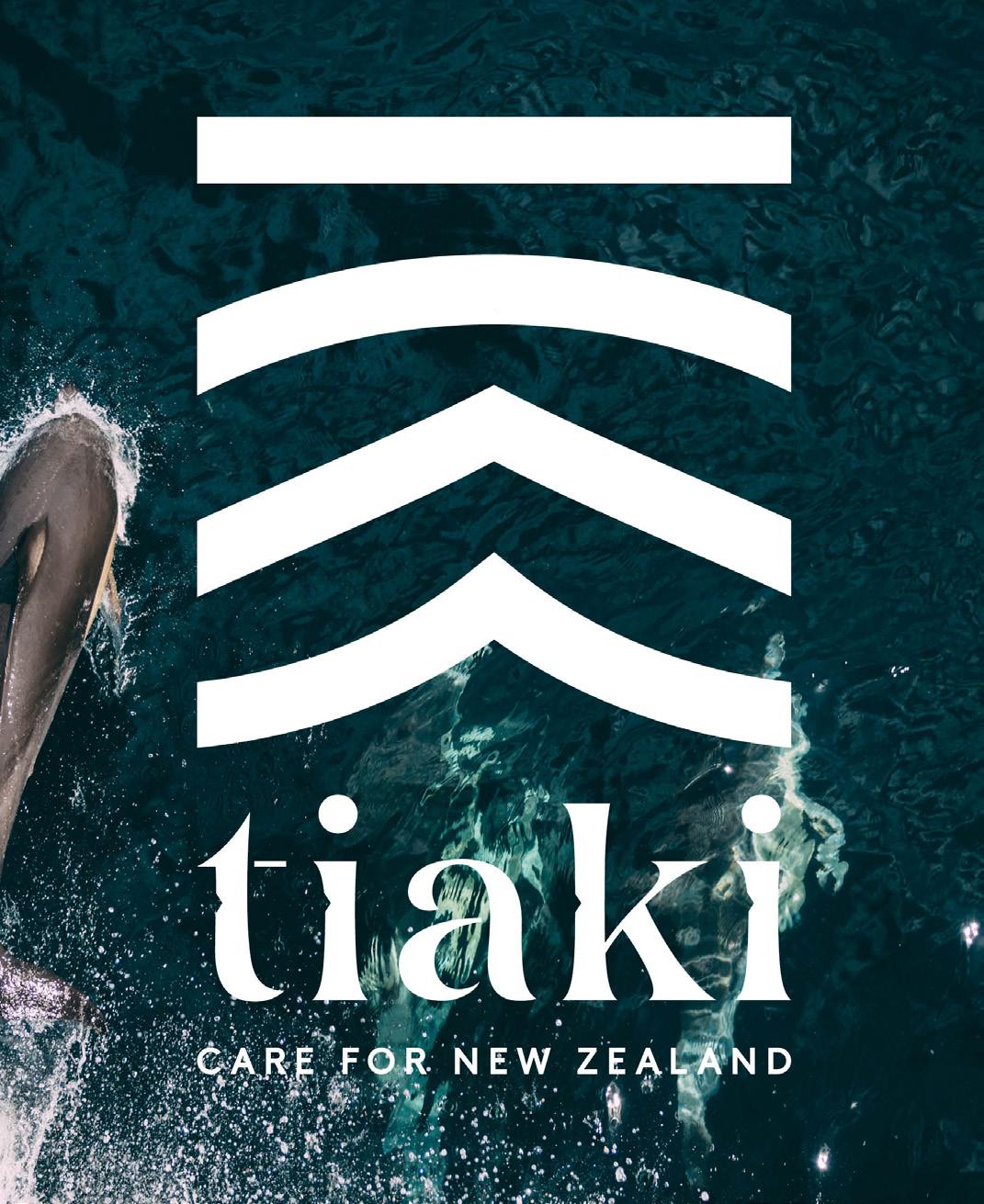

22 Bold employee branding tips – Jodine Bell from Principals explains how to update your employer brand
28 Thriving in the face of challenges –What can people professionals be doing right now to make a difference in the face of a recession?
38 In the midst of a crisis? – Editor Kathy Catton takes a practical look at what to do to support employees in the middle of a crisis


1 From the Editor Kathy Catton
3 Top of Mind
Nick McKissack CEO HRNZ
6 Quick reads
Interesting snippets affecting the HR world in Aotearoa
16 Sustainability
HR will save the world – Kirsten Patterson, at the Institute of Directors asks what role HR can play in the climate emergency we are facing
26 Employment Law Update
Redundancy – get the law right – Sianatu Lotoaso, Dundas Street Employment Lawyers, outlines the crucial factors in approaching redundancy situations correctly
32 HR Technology
Unlocking success with talent mobility and reskilling – Brian Donn, from Ceridian, explains how organisations can find creative ways to do more with less
34 Employment Relations
Flexible workplace investigations – Anna Jackman, DTI Lawyers, looks at the extent of reasonable adjustments and how flexible employers need to be
36 Immigration Law Update
Immigration 2023: A hot topic – Rachael Mason, Partner at Lane Neave, looks at what employers can expect for the year ahead with the immigration system changes
42 Case Law Review
Redundancies in challenging circumstances – David Burton, Employment Law Barrister, looks at a case involving the rushing of a redundancy process
46 Research Update
Working from home: Implications for the future of work – Neeru Choudhary and Shilpa Jain share some of their research into the effects of working from home during the COVID-19 pandemic
48 Am I Managing?
Mike Davy, Chief Member Advocacy Officer at MAS, offers his heart-warming insights into being a manager
8 Book review
Aaron Smith reviews the latest reads to inspire and inform
10 HRNZ Member profile
Sarah Deans shares her career highlights
44 Professional Development Spotlight
Thrive and succeed – Tash Pieterse looks at what’s going to make the difference if we want to thrive and succeed
You will notice that some of our banners and footers have changed in this edition of the magazine.
Our articles will now be tagged with the levels (see left), and domains of knowledge (see the end of each feature article), from our new Capability Framework, The Path. For more information, check out our website!
HRNZ has developed resources to support Members on their journey to craft the employee experience. The Basics is a series of guides that runs through the fundamentals of human resource management.
The HR Guides include Te Ao Māori and te reo Māori, Flexible Working and Culturally Safe Workplaces. These guides are just one of the many benefits of joining HRNZ. Members also have access to the latest guidance and best practice on all areas of employment law, including the Fair Pay Agreements
system, Holidays Act Review and the Accredited Employer work visa system.
HRNZ is a great place to start if you are looking to uphold employment standards in Aotearoa and also want guidance and advice on all workplace matters.
New Zealand’s government declared a national state of emergency in February following the devastating floods and slips caused by Cyclone Gabrielle. During and after a disaster, the health, safety and security of people should be the main concern of all employers and employees.
Back to Work grants are open to Auckland businesses that incurred losses and are unable to operate due to the flooding in early February. This is part of the government’s $50 million package of emergency support.
Employment New Zealand offers employment guidance and support on its website,and HRNZ has a comprehensive article and list of resources on its website. The article covers working from home options, what to do if the employee is unable to work and a checklist for employers to follow.
Anationwide survey of almost 5,000 Kiwis has uncovered fascinating data on our cultural competency, that is, our understanding and application of te reo Māori, tikanga Māori and Te Tiriti o Waitangi principles in the workplace.
Young New Zealanders (aged between 18 and 25) are the most willing to support te reo, tikanga and Te Tiriti at work and show the most confidence when incorporating Māori perspectives and using te reo Māori in written communication. And
women, the survey shows, are more inclined to broaden their knowledge and embrace te reo Māori and tikanga than men are.
The research was undertaken by insights organisation AskYourTeam, in partnership with Te Taura Whiri i te Reo Māori | Māori Language Commission, Te Puni Kōkiri | Ministry of Māori Development, Tatauranga Aotearoa | Stats NZ, Te Hiringa Hauora | Health Promotion Agency and Maurea Consulting. Over two years, 4,900 employees in executive and non-executive roles across 30
organisations took part. The goal, says AskYourTeam’s pou tikanga (cultural advisor) Conrad Waitoa, was to develop a snapshot of New Zealander’s cultural capability at work and help organisations across the motu as they improve their understanding of, and implement or progress, their cultural capability plans.
“What these insights tell us are essentially three things. Firstly, that there is certainly a desire from Kiwi employees to learn more and improve cultural competency.
Secondly, that most of us see te reo Māori as a great doorway to take us through to the wider concepts of equity and better engagement with
Māori. And thirdly, that it’s our young colleagues leading the way – shining a light on the gaps and demanding that we do better.”
Astudy of more than 1,000 New Zealanders has implications for the reputations of organisations currently assessing how, where and when their employees should be working, and for attracting new employees.
The study (discussed in this podcast), commissioned by communications agency Anthem and undertaken by Talbot Mills research, revealed 78 per cent of respondents could not name any companies that they admire for their commitment to flexible and remote working policies. With 46 per cent of Kiwis in paid
employment considering it extremely important to have the choice to work from home when seeking a new job, Anthem’s co-founder and executive chair, Jane Sweeney says organisations are missing an opportunity.
“In this war for talent we are in the midst of, our business community needs to be telling the story of how post-pandemic, emerging flexible and remote working options make companies and organisations desirable places to work. They need to jump on the very real reputational and employee value proposition
opportunities arising from flexible and remote working policies they offer to their staff, and how they engage their staff in developing these policies.”
The survey found that Kiwis were split on their perceptions of remote and office working, with 27 per cent thinking people are more productive working from home, while 30 per cent think people are less productive, and 31 per cent think about the same. Conversely, employers were seen to trust their staff to be as productive at home as they are from an office by 79 per cent of the respondents.
There is a concerning disconnect between how senior and executive leaders in Australia and New Zealand rate their own employee experience, compared with the teams they lead, which directly affects the ability to attract, retain and enable talent, according to new research released by Qualtrics.
Findings from the Qualtrics 2023 Employee Experience Trends Report, based on 2,400 responses from workers in Australia and New Zealand, show 55 per cent of senior and executive leaders say their expectations at work are being met, compared with a third (33 per cent) of middle managers and junior employees.
Meanwhile, middle managers and junior employees report lower levels of wellbeing (67 per cent versus 80 per cent), engagement (66 per cent versus 79 per cent), inclusion (71 per cent versus 78 per cent) and intent to stay (54 per cent versus 63 per cent) than their leaders. Satisfaction with pay also varies between the two groups, with 61 per cent of middle managers and junior employees saying they’re paid fairly for the work that they do, compared with 79 per cent of senior and executive leaders.
“Against the backdrop of increasing rates of burnout, financial stresses caused by the rising cost of living, and evolving employee needs, the
Qualtrics findings must serve as a wake-up call for business and HR leaders across the countries. There is a clear gap in the experience organisations think they’re delivering to their teams and what’s actually being provided. Failure to address it can have serious implications –from struggling to retain top talent, cultivating employee wellbeing, and maintaining productivity and performance,” said Dr Crissa Sumner, Employee Experience Solution Strategist, Australia and New Zealand, Qualtrics.
Help is at hand with timely resources for HR practitioners navigating transformational change initiatives and uncertainty. These three books provide valuable guidance.
Tony Nicholls (2022). Managing Change in Organizations: Develop Your Employees for Business
Transformation. Published by Kogan Page Ltd.
Managing Change in Organizations is a comprehensive guide to navigating organisational change. The book provides a thorough overview of the change process, including how to plan, implement and manage change effectively.

Nicholls provides a range of practical tools and techniques for managing change, such as the Change Curve and Stakeholder Analysis. He also covers various models for change, including Lewin’s Model and Kotter’s 8-Step Model, and provides examples of how they can be applied.
One of the strengths of this book is its emphasis on the human side of change. Nicholls recognises that change can be difficult and stressful for employees, and he provides guidance on managing resistance to
change and maintaining employee engagement throughout the process. Managing Change in Organizations is an excellent resource for anyone navigating the complex world of organisational change. It provides a solid framework for understanding and managing the change process while also emphasising the importance of empathy and communication in achieving successful outcomes. It would be useful for anyone involved in managing change, from business leaders to HR professionals to consultants.
Shauna Moran (2022). Managing Employee Burnout: How to Develop a Happy, Healthy and Engaged Workforce. Published by Kogan Page Ltd.
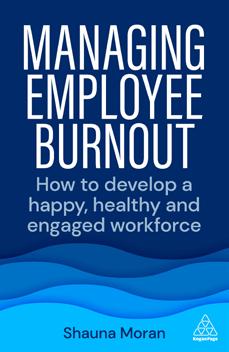
Managing burnout in our workforce has never been more critical. The stress brought on to employees by the COVID-19 pandemic, natural disasters and other events should not be underestimated.
Managing Employee Burnout is a timely and vital guide for any manager looking to prevent and manage burnout in their employees. The book provides a comprehensive overview of burnout, its causes and its effects on individuals and organisations.
Moran provides practical strategies and tools for managers to identify,
prevent and manage burnout in their teams. She emphasises the importance of creating a supportive and positive work environment, with a focus on communication, flexibility and work–life balance.
One important point Moran highlights in this book is that of the individual experience of burnout. Moran recognises that burnout is not just a problem for organisations, but also a deeply personal experience for employees. She provides guidance on how managers can support employees through burnout and help them to recover.
Moran’s writing is engaging, making the book accessible to many readers. It is also filled with real-life examples and case studies, which make the concepts easy to understand and apply in practice.
Lucy Widdowson and Paul J Barbour (2021). Building TopPerforming Teams: A Practical Guide to Team Coaching to Improve Collaboration and Drive Organizational Success. Published by Kogan Page Ltd.
Building Top-Performing Teams is a practical guide to building and leading high-performing teams through team coaching. The book offers a comprehensive overview of team dynamics, covering topics such as communication, motivation and conflict resolution.

Widdowson and Barbour provide a compelling argument for structured coaching of high-performance teams. They outline the practical tools and techniques for building and managing teams, including methods for identifying and addressing team weaknesses and strategies for developing effective team culture. They also cover the importance of effective leadership, including how to inspire and motivate team members and how to create a vision for success.
The writing is easy to follow, and the authors also provide real-world examples, which help to make the concepts easy to apply.

Building Top-Performing Teams is a valuable resource for anyone looking to build and lead a successful team. It is an excellent guide for managers, leaders and anyone involved in team management, providing practical strategies and tools for achieving high performance and success.
Aaron Smith (EPMHRNZ, MBA) is a People & Culture Manager with Scenic Hotel Group. After taking up an HR administration role, he discovered a real passion for the profession. He has an interest in recruitment and employment relations and likes to keep up to date with developments in employment law.






My career highlights are centred on building a great culture and seeing the positive impact that it has on people and the organisation’s ability to achieve its goals. For me, that’s about putting strategies or initiatives in place that enable change and growth, it’s often a slow burn because building culture takes time and determination. What that looks like can be anything from building capability in leaders by encouraging them to have quality day-to-day interactions with their people, leading by example when the going gets tough and creating trust so people feel safe, or creating experiences that build connection and give people a sense of shared purpose and achievement.
Years ago, at a company-wide end-of-year celebration, I led the co-creation of a new employee awards programme. We made a
big deal about it by building up the anticipation for the final award. When the winner was announced, there was a roar of clapping and cheering, the atmosphere was incredible. It was successful because we included everyone’s ideas and voices and thought deeply about what it meant to truly belong and succeed in our organisation. I still smile when I see their annual awards posted online and know I played some part in that.
On a macro level, I’m motivated by organisations doing great work and being good citizens, looking after their people, contributing to a strong economy and society that is sustainability led and cares about the planet. HR has an incredible opportunity and responsibility to influence positive change. We have some big, hairy challenges ahead of us, and you need to be up to the challenge if you work in HR.
On a micro level, I really like being at the cross-section of strategy, people and systems, and working to align all of them so that they work in harmony. It’s not easy to achieve, but when it happens, it is magic. That’s why it’s so crucial that HR leaders and their teams understand the business because that enables everyone to succeed.
As a profession, we need to constantly look to the future, read the signals on emerging trends and issues, be agile, resilient and adaptive, and not afraid to take risks. But we also need to know when to be on and when to switch off. Tremendous social, environmental and political changes are happening that also affect the workplace: hyperfast changes in technology, a rise in mental illness, burnout and stress. Hybrid working has changed the way people connect and has created an improved work–life balance, but that also comes with challenges around engagement, communication and presenteeism. On top of that, the economy and inflation are big issues right now. HR needs to be across all these things. So, what’s crucial now is creating great employee experiences, building inclusive workplace cultures, and consciously prioritising your time and energy.
I joined as a student and attended as many special interest groups as possible, to learn from experts in their field. The broad base of learning was invaluable. HRNZ has been a bit like a life coach for me, especially when

I needed guidance and advice as I’ve progressed through my career, and now I have gained Chartered Membership. I’m impressed with the new capability framework ‘The Path’,

and the way the HR capability levels extend all the way from Delivers to Governs. Knowing HR is recognised at a governance level for the value and impact it delivers is fantastic
because it’s critical to setting vision and strategy across an organisation’s culture. HRNZ will absolutely continue to be relevant to me as my career evolves.


Sarah: Last year, I was saying things were uncertain and fragile, and this year I hate to say that I’m saying the same, but maybe even more uncertain and fragile with an election in the mix. At the end of 2022, everyone was using the “R” word (recession) about 2023, but towards the tail end of the year, economists started to be a tiny bit more optimistic. The thing to watch is the regular Reserve Bank Monetary Policy Statement and anything that has a consensus forecast, because that tends to capture a broader view of market expectations.
One thing is clear: the labour market continues to be tight. However, there are very, very early signs of things that will help it ease. You
see government decisions around loosening immigration settings and increasing the number of recognised seasonal employer (RSE) workers, which will help some employers. But the economy continues to fight against inflationary pressures and this is being made harder by the aftereffects of Cyclone Gabrielle. High wage expectations and increases in average hourly earnings that are outpacing inflation make the problem even worse for employers. The cost of living is, of course, really hitting our employees’ back pockets. So I would say tighten your belts for a busy year, one where you’re going to have to be nimble to adjust to rapid changes in conditions.
The Reserve Bank was pretty direct in its recent Monetary Policy Statement saying that inflation remains too high, and the labour market remains very stretched. They have specifically called out higher wages as contributing to inflation. However, most people are keeping a keen eye on what is happening with job vacancy numbers. The macroeconomic data is starting to look like job vacancy rates may be reducing.
Sarah: 2022 was not kind to global labour markets. We saw an uneven recovery from the pandemic and further supply shocks, including
those associated with the war in Ukraine. The International Labour Organization is using a global unemployment rate of 5.8 per cent – or 268 million people – and the worst picture is painted for women and young people. The World Employment and Social Outlook for this coming year makes for grim reading.
It is going to be another year of keeping your offer current and your pencil sharp.
When you look at countries we tend to compare ourselves to –like Australia, which is in a similar position to us – they came out of COVID-19 okay, but they are now grappling with wage pressures, higher inflation, labour shortages and uncertain economic conditions, mainly driven by the uneven economic performance in China.
The World Economic Forum Global Risks Report has identified five main risks for the next two years:
• the global cost of living crisis
• economic downturn
• economic warfare
• a hiatus in climate change action
• societal polarisation.
All of these will require attention from business leaders and HR professionals.
HRNZ: This is sounding bleak. What should HR leaders be prepared for?
Sarah: So things aren’t great, but New Zealand has a lot going for it compared with others. Employment levels are high, participation rates are good, and government debt is relatively low by international standards. This last point is particularly important as the government looks at the financial cost of the tragic impact of Cyclone Gabrielle.
We could all do more to get more young people into jobs, because they are the ones who are really finding it hard. It will be particularly rough for those who didn’t finish their education because of COVID-19 and instead went into low-wage work.
They may now find themselves out of a job, carrying student debt and with half-complete qualifications.
… you’re going to have to be nimble to adjust to rapid changes in conditions.
Risk-wise, I would be keeping on top of the way economic conditions are affecting your organisation. At MartinJenkins, we are working with organisations that will need to move quickly to cut costs (some have already begun). It will be essential to understand your current workforce composition and where you might be able to make efficiencies, and know how to run a change process that’s fair and legally watertight. Everyone thinking about whether they might
need to right-size their workforce should familiarise themselves with the Employment Court’s recent decision ordering AUT to start its mass redundancy process again from scratch
Some businesses will be more resilient in the face of economic conditions and may continue to hunt for talent – and talent may get easier to find. Wage expectations continue to be high, and there may be a bit of a lag between worker expectations and affordability in light of all the economic uncertainty that employers have to factor in. So you need to have bargaining strategies in place, particularly considering the new Fair Pay bargaining arrangements.
HRNZ: What does this mean for retaining talent?

Sarah: Holding on to talent is always important to your organisation’s performance story. The key is to understand what talent you need to achieve your strategy, and whether the people you have are talented and performing in the way you need them to. This is true regardless of economic conditions. But with the current uncertainty and the potential for restructuring in sectors exposed to uncertainty, you may need to consider ways you can reconfigure your workforce to address these risks. As an example, this might include reducing hours rather than turning to redundancies.

Outsourcing often looks more attractive when the labour market is uncertain. But pay attention to last year’s Employment Court decision on Uber’s contracting arrangements Make sure the arrangements you put in place are appropriate and defendable and that you’re not just shifting risks to those who can’t manage them. And make sure any decisions about outsourcing or reducing hours are going to help – not hinder – your organisation’s ability to achieve its strategy. Finally, keep an eye on those you work with to ensure they are meeting minimum employment standards as their margins face pressure.

HRNZ: What about attracting talent?


Sarah: It is going to be another year of keeping your offer current and your pencil sharp. The changes to immigration settings also mean you may be able to access talent
from offshore. It will be particularly vital to give these employees a positive experience of work, given the government’s focus on taking regulatory action against migrant exploitation.
your organisation.
A focus on professional development and upskilling may also come back to the fore. Some organisations we work with have blown their budget on recruitment costs and have sometimes funded it by cutting training. With labour shortages, we have also heard of people cutting back on training to cover core service delivery. You may find you have the time and the budget for training now – investing in your people is never a bad idea.
HRNZ: Any final words of advice for HR professionals?





Sarah: Your own resilience. This could be another year where HR leaders need to make sure they put on their own oxygen masks before they help others. Take time to look after yourself, and stay focused on strategic priorities that will really help drive your organisation’s performance. And good luck.
Domains of knowledge



[keep] on top of the way economic conditions are affecting



Don’t miss the event that brings together inspirational speakers, the latest industry trends and insights, and hundreds of ambitious, determined professionals looking to get an edge in their career.



FULL DETAILS AT: WWW.THINKTANKMEDIA.NET/ELS
MENTION HRNZ FOR A 10% DISCOUNT! SIMPLY USE CODE HRNZ AT CHECKOUT
WWW.THINKTANKMEDIA.NET/ELS
You don’t need to be a climate scientist to see the evidence that the world is heating up and climate change is real. That reality is going to affect all of us, whether we are businesses, employees or community members. It is going to affect how and where we work, travel and live our lives.

We are headed into a once-in-ageneration change in the way our world is structured. This is going to require global, organisational and human change. And that’s going to need talented HR leadership. Research tells us that employees don’t just want to be a cog in a machine, they want to work at a place that has a vision, a purpose and adds value. Above all, employees want to feel like they are contributing to something meaningful, which means that organisations with a clear purpose are more likely to attract and retain scarce talent and capability.

The Minister of Climate Change, Hon James Shaw, has warned:
This decade is make or break for the planet. To stand a chance of limiting global warming to 1.5˚C, the science shows we now have about eight years left to almost halve global greenhouse gas emissions.
Climate change is as much a people issue as it is an environmental and biodiversity issue. Eight years is within the working life and responsibility of all of us.
Our 2022 Director Sentiment Survey asked directors and board members
to choose up to three future trends that they were currently paying attention to. The top factors were talent and climate change.
The boards of our banks and large financial institutions are, right now, putting in place plans to report on their 2023 emissions profiles and climate-related risks and activities under New Zealand’s world-leading Financial Sector (Climate-related Disclosures and Other Matters) Amendment Act 2021.
This is the first mandatory climate reporting regime anywhere in the world, and we will see those disclosures in the 2024 reporting season. It’s always challenging to be
first. Even if you are not in a large entity, this standard will become the norm and the expected standard for us all to follow in the coming years.
The World Economic Forum asked the New Zealand Institute of Directors to be the host of Chapter Zero New Zealand. The mission of Chapter Zero New Zealand is to mobilise, connect, educate and equip directors and boards to make climate-smart governance decisions, thereby creating long-term value for both shareholders and stakeholders.
Chapter Zero is about helping directors to make climate a
boardroom priority. Chapter Zero offers open access to resources, regular news and updates, and connection through free webcast events and more. If your board members and CEO haven’t joined the free Chapter Zero New Zealand community, encourage them to do so.





Strategic people and culture leadership, when well-delivered, can be transformational. As HR leaders, your decisions are far-reaching. They affect your respective organisations, but, more broadly, they affect our communities and our New Zealand. There was a great quote from Sir David Attenborough at COP26:
We are, after all, the greatest problem solvers to have ever existed on Earth. If working apart, we are a force powerful enough to destabilise our planet. Surely working together, we are powerful enough to save it.
What will your legacy be? And where will you lead us in the next eight years?
As you reflect on the climate emergency and what it means for your organisation and for your leadership, I would encourage you to also reflect and discuss the following five questions.
1. What is HR’s role in climate leadership? What are you doing to upskill and lead?
2. Do you know your number – your carbon emissions? Are you ready to scope the emissions, including staff travel, for example? (Do you know what they are?)


3. What does decarbonising mean for your organisation and for roles and people? What does a just transition look like for your people?
4. What capability will you need?
5. How do we remunerate and incentivise climate-positive behaviours in our CEOs and leadership teams?
Kirsten Patterson is a qualified lawyer and a Distinguished Fellow of the Human Resources Institute of New Zealand, Co-deputy Chair of the Global Network of Directors Institutes (GNDI), Chair of the Brian Picot Ethical Leadership advisory board and previous Chair of the Wellington Homeless Women’s Trust. With extensive governance and leadership experience, she is actively involved in community initiatives.


The 24th year of the NZ HR awards attracted over 450 attendees, who came together for the night to connect and celebrate success across the HR industry.


Organised by HRNZ, in association with Principal Partner MAS, the NZ HR Awards are the pre eminent accolade for human resources management in Aotearoa, New Zealand. The Awards provided the perfect opportunity reflect on, appreciate and celebrate all the hard work across the profession over the past 12 months, and recognise excellence across numerous awards categories.
The HR Person of the Year Award is selected from the individual award winners, for the most impactful contribution to the HR industry in Aotearoa. Winner of the Leadership Award, Laura Warren, also came away from the evening as HR Person of the Year.
Laura has shown outstanding leadership in the HR profession in New Zealand. As Deputy Chief Executive: People, Culture & Safety at Otago Polytechnic, she leads across a broad HR spectrum daily. Laura contributes locally and nationally to best-practice, people-focused strategies and workplace culture.
She is known for her pragmatic, authentic and engaging approach and her positive impact in both strategic and operational plans and decisions. Laura is an active part of the HRNZ community and held the role of President for HRNZ’s Otago Branch for the past three years.
Z Energy won the HRNZ Supreme Award for greatest overall leadership in HR practice. Also winners of the Innovation Award, Z Energy came away on top thanks to their hard mahi on closing their organisation’s gender pay gap. Salary transparency, an innovative KiwiSaver offering and systematic modelling of their gender pay gap, have helped Z Energy, deliver their objective to completely close their pay gap by FY2024.
The Outstanding Service Award was presented to Kirsten Patterson DistFHRNZ, CEO at the Institute of Directors. Kirsten (KP) has a background in HR, which catapulted her into a successful career in governance and working as a chief executive. Despite her new career focus, KP maintained her support and association with HRNZ. She continues to help in shaping the profession via presenting and contributing as mentor, chartered assessor and awards judge.
The Individual Awards recognise leading HR professionals across Aotearoa. These are professionals making a meaningful difference, championing change and leading HR best practice.
For her excellence in her role as an Associate, ER/HR Consultant and Licensed Private Investigator for Baker Tilly Staples Rodway, Kerry Tattersall was the recipient of the HR Professional of the Year Award. Outside of her work, Kerry contributes to HR through her role as Branch President of HRNZ’s Hawkes Bay Branch, and as an assessor for Accreditation with HRNZ. “Kerry’s strength lies in the ability to slice through communication knots to enable a positive outcome by the power of restorative practices and coaching techniques.”
The Emerging HR Practitioner of the Year Award identifies emerging HR
talent and was awarded to Jason Cook, HR Manager at Mt Pokaka Timber Products. Jason finds his work extremely rewarding. “The HR profession allows me to critically think about solutions to challenges faced by my organisation.”
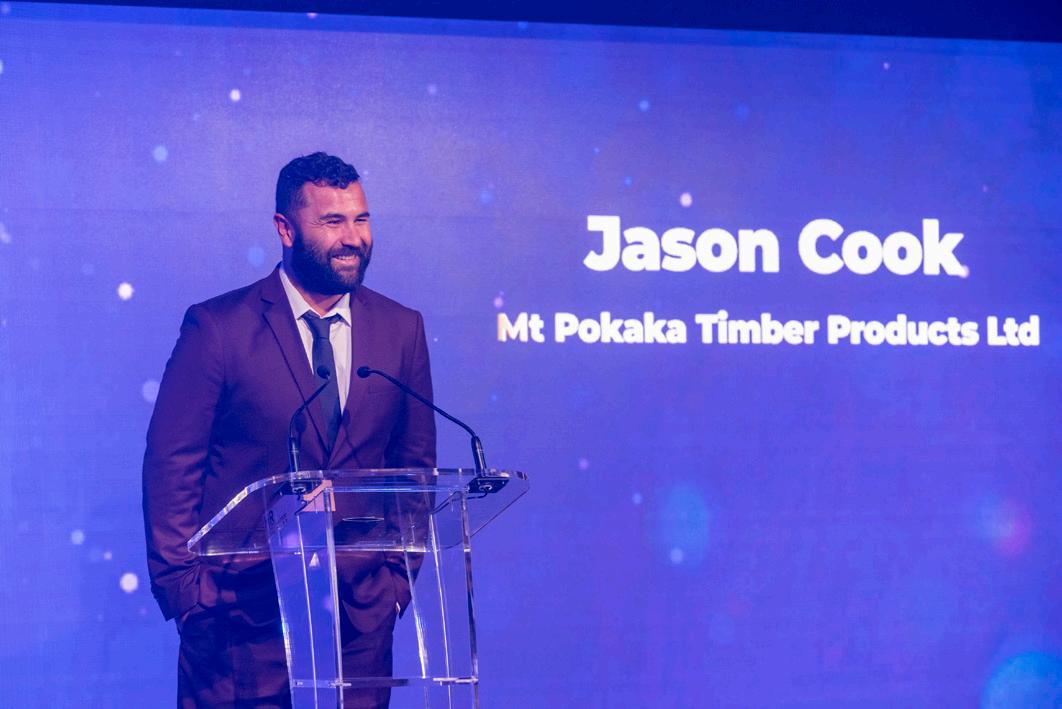
Another up-and-coming HR star is Rebecca Jackson, who was named HR Student of the Year. Rebecca is beginning a career in HR, after
recently completing her studies of Human Resource Management at Massey University. In 2022, Rebecca was an HRNZ Student Ambassador and a valuable member of the Manawatu Branch Committee. We look forward to seeing the great things Rebecca does in the future!
The winner of the inaugural Wellbeing Leadership Award was Sarah Mason, the National Wellbeing

Manager at Fulton Hogan. Sarah has led the implementation, evaluation and development of Fulton Hogan’s hugely successful nationwide wellbeing programme, which has achieved increased awareness and understanding of wellbeing in the workplace.
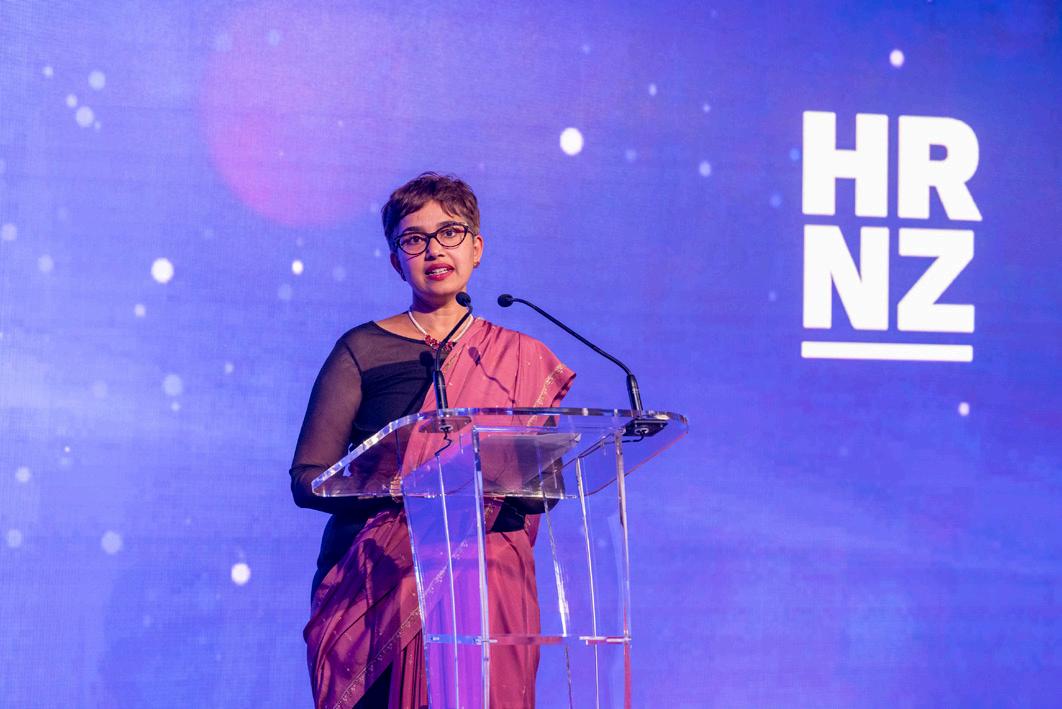
The Academic Impact Award was also introduced for the first time at this year’s awards. This award

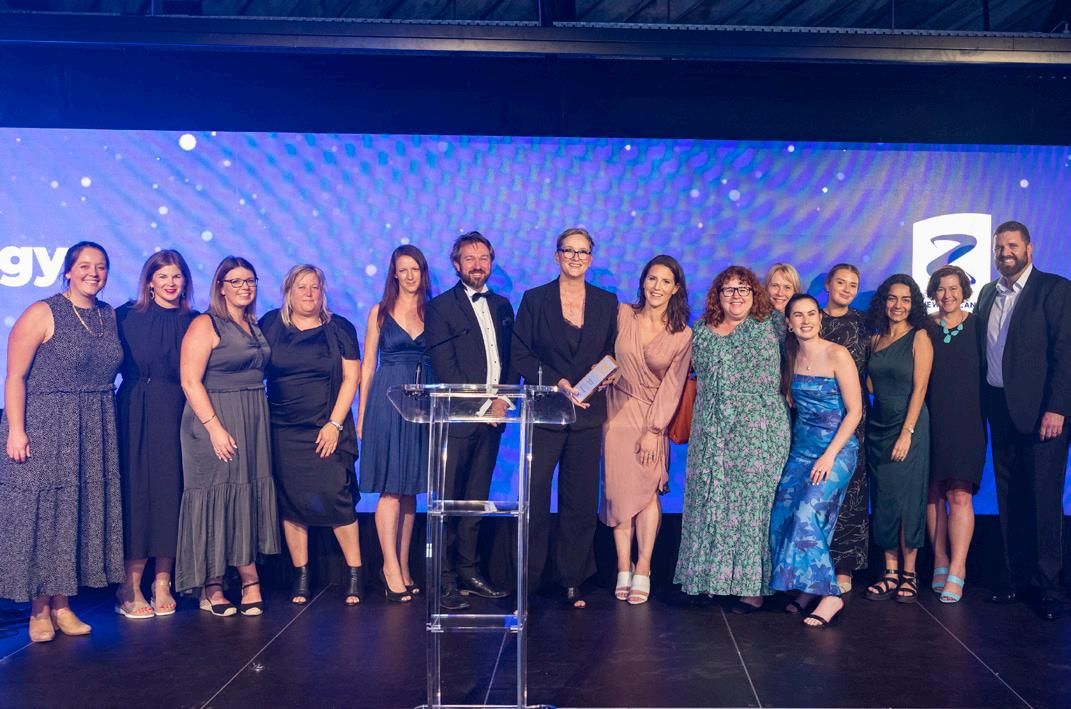
went to ‘job crafter’ Deepika Jindal. Deepika is a reflective academic, who is passionate about HRM, and strives to add value to her students, the University of Auckland and the wider community.
The Mana Tangata Māori HR Awards recognise individuals or organisations who incorporate bicultural HR practices into their work, enacting tikanga Māori.

For their emerging work on bicultural practice, Te Whatu Ora, Waitaha me te Tai o Poutini won the Emerging Māori HR Award. Te Whatu Ora recognises that by improving the diversity of their staff, they can better serve their patients. “If our patients can see themselves, they are more likely to have a positive experience in our system.” They have designed a three-stage tikanga-based recruitment process that is based on core values: whanaungatanga, arohatanga and manaakitanga.

As a leader in enacting tikanga Māori in the workplace, Otago Polytechnic – Te Kura Matakini ki Otago, were awarded the Leader Māori HR Award. In close partnership with the Office of the Kaitohutohu (KTO), their People and Culture team has been on a journey of developing bicultural competency that has enabled a significant shift in their thinking and practice that is more culturally responsive and inclusive for Māori.
The Organisational Awards recognise leading HR teams and organisations across Aotearoa that are shaping workplaces through championing change and leading HR best practice.
The Talent Acquisition Award went to Tonkin + Taylor, for their ‘Suits me to a T+T’ digital recruitment campaign. With borders shut and a highly contested pool of talent, T+T created dynamic web-based domestic and international recruitment campaigns. Their No. 1 goal was to achieve the impossible: fill a list of 75
specialised vacancies. Despite huge challenges, they have made 138 new hires from January to September 2022, surpassing pre-COVID-19 hiring levels.
The Learning and Development Capability Award went to Southbase Construction, for their Competency Framework initiative, which focused on providing their people with an easy-to-use guide on how to perform key construction management tasks. People appreciate that the framework clearly shows how they meet
expectations and provides feedback on performance.
The Diversity and Inclusion Award went to Education Perfect, for their EAL (English as an Additional Language) initiative, which focused on making their workplace a more inclusive place for non-native English speakers who make up 22 per cent of their workforce. As a result of Education Perfect’s Diversity, Equity and Inclusion committee and their initiative, 91 per cent of non-native English speakers agreed “I feel that
my manager cares about me and supports my specific needs as a non-native English speaker”, and 75 per cent responded positively to the prompt, “as a non-native English speaker, I feel included and valued at Education Perfect”.
Te Whatu Ora, Te Toka Tumai won the Wellness Programme Award for their Awhi Oranga (Employee Support Centre) initiative. The call centre was implemented in 2020 during COVID-19 when support for the people of Te Toka Tumai was crucial. Awhi Oranga has enabled Te Toka Taumai to support their workforce during a critical time in the industry. This initiative has provided practical, meaningful support to all their workforce, and particularly those who need it the most.
The Technology Award went to Tompkins Wake for their initiative involving the digitisation of their HR systems and operations to ensure they were efficient and fit for purpose. They started the major overhaul in 2019, and by researching and investing in new software and developing new systems and
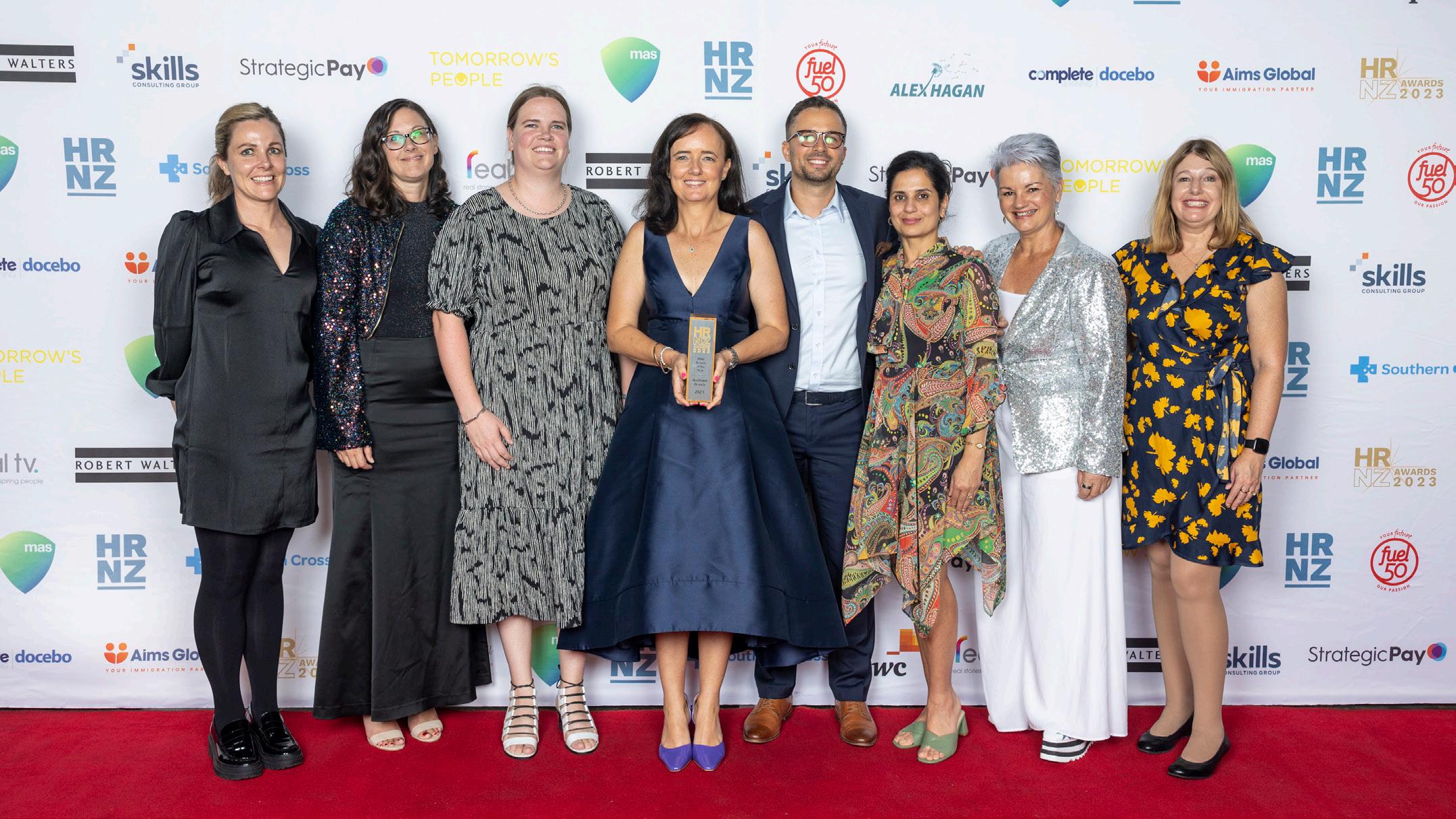
processes, they have been able to improve communication between their offices and staff.
My Food Bag won the Organisational Change and Development Award for their ‘Secret Sauce’ initiative. Their ‘Secret Sauce’ defines their values and behaviours and, in turn, the symbols and rituals to support a high performing culture. Their efforts have increased retention by more than 50 per cent as well as generated a strong lift in engagement.
The Future of Work Award recognises organisations that are paving the path to the future of work. This award went to ACC for their Sustainable Hybrid Working initiative, which aimed to make sure that work was better for their people, while continuing to meet and exceed customer expectations.
Another new award, Building Sustainability through People Award was awarded to Mitre 10 New Zealand Ltd for their sustainability initiative. Taking a human-centred approach to sustainability has improved
awareness and engagement around sustainability at all levels and has resulted in an exciting cultural shift within their business.
Having facilitated 73 topical events over the year, Auckland Branch were the well-deserving winner of the HRNZ Branch of the Year Award for 2023. Auckland Branch have seen consistent growth thanks to their proactive engagement with membership, their connection in building and fostering relationships, and their focus on career development. “We hope our members have gained a great deal from our collective efforts.”
With multiple industries facing a talent crunch in a challenging economic period, now is not the time to be restrained by your master brand guidelines when designing or updating your employer brand. Principals’ Jodine Bell explains.

If ever there was a year to have a bold employer brand, this is it. With the focus firmly on employees and the employee experience, now is the time to take an objective and open-minded look at your internalfacing brand to see whether it is working in your organisation’s favour, specifically for existing staff and potential new joiners.
Let’s step back for a second and define what we mean by an employer brand. We’re all familiar with external branding. That’s the face of an organisation the world sees. From a design perspective, it includes the logo, the colour palette and distinctive brand assets, such as graphic devices, strap lines and the tone of voice.
An employer brand is an extension of this external brand, but it has several roles to fulfil that the external brand does not. It needs to speak to the organisation’s culture, the way teams
see the business and how it operates. If it’s done well, it will inspire and motivate existing employees while exciting and enticing new recruits. The two aspects of your brand should have common elements; however, the employer brand needs to do some heavy lifting in the areas where the external brand does not. This gives you scope to have fun and break away from your established brand guidelines.
For a start, any employer brand needs a concise umbrella promise, positioning, story and values, like Vodafone’s – now One New Zealand ‘Freedom’ employer value proposition (EVP). This was developed by working with the company’s people and culture team and facilitating staff workshops to explore why people like working for the organisation. The result is flexible ‘freedom’ messaging and an EVP platform and identity: freedom to design your career, to have autonomy and ownership of exciting projects, to work flexibly and remotely, to have a good work–life balance, to pick the kids up from school, for example. With numerous industries currently experiencing talent shortages, there is an increased focus on the employee experience, with firms able to lure great talent with the promise of a better culture.
The New Zealand government is working to combat the shortages by doubling the working holiday intake and fast-tracking permanent residency for temporary migrant workers. But this will take time to kick in as the impact of limited migration and COVID-19 continue to bite.
In the meantime, the employer brand is a powerful tool to help businesses retain and attract staff.
Case in point is the successful Fulton Hogan ‘Good Work’ EVP that appeals to a range of staff from road workers to senior executives. Fulton Hogan is an 80-year-old, multibillion dollar, still family owned and values-based company with 8,000 staff across Aotearoa New Zealand, Australia and Fiji. ‘Good Work’ was developed after 22 workshops with everyone from teams in Townsville to highway maintenance crews in Dunedin and Central Otago.
If you want to compete in this climate, you’ll need to consider how your organisation can stand out. Companies that don’t respond to this moment risk not having an impact or, worse, getting left behind.
During economic uncertainty, job insecurity and financial stress can also affect employee engagement with a brand. This can be mitigated through your employer brand. Put
it to good work by promoting open and transparent communication. Encourage everyone to participate in innovative thinking on business growth and cost savings. Offer support and resources to manage financial stress. Recognise and reward employees for their contributions, and provide opportunities for professional development and career growth.

Additionally, companies should remember to create a positive company culture and emphasise the mission and values of the brand to foster a sense of belonging and purpose for employees. It’s obvious but when times are tough it’s easy to forget.
With everyone taking stock, consider how you can make your employer brand convey high energy. Make it

friendly, lively and reflective of the space, place and culture people want to work in. It is particularly important for businesses that are also looking to get people back into the office post-COVID-19 lockdowns. You want your people to view a workplace as an extension of their lives rather than something they don’t enjoy, and your employer brand is the perfect way to make that happen.
Looking at the challenge through a design lens, there’s the opportunity
Employer branding is critical to any organisation’s recruitment and retention strategies. Tips to consider when enhancing your employer brand.

• Clearly define your organisation’s values and mission – ask your teams for input.
• Ensure your recruitment process is transparent and job adverts accurately reflect your company’s values and culture.

• Invest in your current employees: how is every employee’s work meaningful and competitively compensated? What learning and development opportunities are there? Is the working environment inclusive and supportive?
• Work with your marketing team on employer brand consistency across all channels – website, social media, brochures and so on.
to step away from your day-today brand feel and main brand guidelines to create an expression that opens up the appeal of working with you. Get more creative and playful with how your brand can function.
Remember, you’re not talking to clients. You’re talking to your people. You want these to convey the ethos of your brand to others. By making it interesting, inspiring and fun for them, they’ll be happy to imbue your EVP and values in their interactions with each other and customers. The same goes for applicants and potential staff. Word of mouth is recruitment’s holy grail. Even if they don’t join you, if you’ve clearly articulated and expressed what you’re all about and why you’re a good employer, it will get out and about. Like good gossip about a good restaurant.

It’s okay to differentiate and be more real. And talk to your
employees about the power of employer branding. The caveat, of course, is that you need to be a good employer with a healthy culture. But if they’re happy, your people’s voices will help you to attract and retain more talent.

The talent squeeze is far from over, and an employer brand is a tool you have at your disposal to get your organisation through. So why not go bold – what have you got to lose?
Jodene Bell is the Creative Director of brand agency Principals in Auckland. Jodine’s career has gone from strength to strength from the early days of digital design to packaging and brand. She’s developing a team and culture with Principals that is creating amazing design work for small business and large corporates both locally and across the ditch. To find out more, visit principalsbrand.co.nz



In times of a recession, more job cuts may well follow.
Earlier this year, it was reported that Microsoft announced by a mass memo that 10,000 staff redundancies would occur, which is almost 5 per cent of its workforce. Microsoft is the latest big tech company to announce mass redundancies, after Amazon, Meta and Twitter. More recently, and locally, online investment platform Sharesies is reported to have proposed a restructuring with job cuts to be likely.
Employers who simply announce redundancies as a “done deal” without any form of consultation will expose their businesses to expensive legal claims for compensation and lost wages. The courts have made it clear that an employer’s inability to make payment will have no bearing on the remedies awarded to an employee who successfully establishes a personal grievance. This makes an already bad situation worse, considering the business’s financial struggles likely triggered the redundancy in the first place.
To thrive in a recession means getting the law right when it comes to redundancies. Proactive legal
advice around your obligations as an employer, early on, will minimise the risks of your proposed changes becoming a liability.
When it comes to redundancies, employers must:


• have a genuine business case for change (substantive justification)
• follow fair process (procedural justification)
• consider alternatives to dismissal, including redeployment into a suitable role that the employee could do.
Since 2013 the Employment Relations Authority and courts are now able to investigate the merits of an employer’s commercial rationale
for a restructure decision. The leading decision on this is the Court of Appeal’s Grace Team Accounting v Brake.
In Brake, Brake was provided with a proposal to make her redundant after six months of employment that was based on financial data recording a loss of around $60,000 in the financial year. Brake showed that the decision to make her redundant was based on incorrect information (Brake was an accountant, after all), and Grace Team Accounting had actually made a profit of around $60,000. This error meant that the redundancy could not be substantively justified. But could the courts investigate an employer’s business rationale for a restructure? The Court of Appeal confirmed that the Authority and courts could pierce the corporate veil to test an employer’s reasons for making an employee redundant. This means employers must take care to ensure that they have a sound commercial rationale for a restructure that can withstand prying judicial eyes.
As mentioned above, employers must also follow a fair process, which includes meeting their duty of good faith. The duty of good faith requires an employer who is considering a redundancy to provide the employee with information relevant to the decision and relevant to the continuation of the employee’s

employment, and provide the employee with an opportunity to comment on that information before any decision is made.


In Innovative Landscapes (2015) Limited v Popkin, the Court held that, although there were genuine reasons for the redundancy, the procedure was fatally flawed. These procedural failings included the company director:
• not consulting with Popkin about the possibility of redundancy before he made his decision; not considering if there were any alternatives to dismissals
• not providing Popkin with any information to enable her to understand and engage meaningfully in a consultation process
• not obtaining Popkin’s views and considering them with an open mind before he made his decision.

This part of the process is often overlooked. Even if an employer has a genuine business case and follows the correct procedure, they may still fall at the final hurdle if they do not carefully consider alternatives to redundancy, including redeployment to other suitable roles. This includes considering and genuinely consulting with an employee about suitable roles that the employee could do, including vacancies within the
business or new roles created by the restructure. It also includes, and is equally important, engaging with an employee about why you have decided these roles are not suitable either.
Employers who do not meet their employment law obligations could be held to account when all of it is over.

Sianatu Lotoaso is an Associate at Dundas Street Employment Lawyers. Sianatu provides advice on all aspects of employment law and the employment relationship. Sianatu regularly provides advice to a range of clients in the public and private sectors.
Domains of knowledge

According to HRNZ’s latest Member Voice Survey, the biggest challenges for 2023, as told by HRNZ members, are recruitment and retention. Vicky Yeo, Partner, and Millie Gracie, Senior Consultant in Organisation Transformation at Deloitte, and Human Resources editor Kathy Catton look at what people professionals can do to make a difference in these areas.
professionals, regardless of their role or sector. Let’s break it down.
Employee retention starts at the recruitment stage, so this may be a time to review all life-cycle processes, programmes and strategies to ensure they are relevant and fit for purpose.
Vicky suggests the following strategies to improve employee retention and contribute to the organisation’s employee value proposition (EVP):
career advancement by providing regular performance evaluations and coaching to help employees improve and grow
• recognise and reward employees for their contributions and work
• offer and maintain competitive salaries and benefits packages

• provide work–life balance through flexible scheduling and remote work options
Employee retention starts at the recruitment stage.
We’ve heard it from all directions: The labour market is tight, employee turnover is rising and staff shortages are commonplace within HR and the wider workforce. So it’s no surprise we’re facing increased pressure from a resourcing, wellbeing and cost perspective. And all this is in the context of the rising cost of living, rising interest rates and uncertainty over global events. Continued leadership and influence and finding innovative solutions will be crucial for success for HR
• create a sense of purpose and meaning in the work employees do
• create a positive and supportive work environment that values and respects employees, establishes trust in leadership, and builds a positive corporate culture that aligns with the organisation’s values
• co-design your employee talent experience: listen to people and understand what the employee experience is like and where there are opportunities to improve, by encouraging open communication and providing opportunities for employees to give feedback
• provide opportunities for professional development and
• invest in employee wellbeing and offer employee assistance programmes. Having employees at the centre of any listening strategy is crucial. This includes then taking action based on the feedback received. People are savvy and have access to multiple media to voice their concerns. Be honest and remember that inaction will create distrust and fatigue. Waiting until an employee’s exit interview to find out why they’re moving on is too little, too late.
According to Vicky, organisations need to understand and prioritise employee engagement during a recession.
“We know when employees are engaged, they are more motivated, productive, and committed to their work and success of the organisation. This not only ensures organisations continue to operate smoothly and adapt to the tough economic conditions, but it also means employees are more likely to stay with the organisation, reducing potential turnover, costs associated with recruitment and onboarding new employees, and retaining institutional knowledge.”
“Having an engaged workforce also contributes to a positive organisational culture, which is important to maintain high morale and attract and retain top talent in an impacted market,” says Vicky.
offer in the way of learning and development during economic hard times?
As an organisation looks to make changes to its strategy and how it may operate differently during a recession, work should be carried out to identify what future capabilities will be required to be successful. Therefore, investment in those capabilities should be prioritised (eg, customer centricity, adaptability, innovation), says Vicky.
“Organisations should also consider offering job-specific training programmes, such as on-the-job training, mentoring and coaching. This can help employees build specific skills and knowledge they need to succeed in their roles and to take on new responsibilities as the organisation adapts to changing market conditions.
“It is even more important that people are cross-skilling. Where roles and responsibilities may overlap across the organisation, or where there is opportunity to do so, building additional skills to support crossskilling will be beneficial.”
Companies should proactively create an irresistible experience – a magnetic organisation that empowered, free-agent people can’t help but want to join.
According to Deloitte’s 2023 Global Human Capital Trends report, which surveyed 10,000 business and HR leaders across 105 countries, leaders today can be anyone who mobilises workers to get work done, and is no longer contingent on position, hierarchy or the number of direct reports. This is an opportunity for HR to reframe
roles in a future space that may lack the boundaries of job titles.
And what about optimising the human–technology mix?
Optimising the human–technology mix involves finding the right balance between using technology to automate tasks for efficiency and using human resources to perform tasks that require and benefit from creativity, critical thinking and problem solving.

Vicky suggests that the ways and considerations to optimise the human–technology mix might include:
• understanding the capabilities and limitations of technology
• identifying areas where automation can improve efficiency
• using technology to augment human capabilities
• empowering employees with the necessary tools and training
• continuously evaluating and adapting the human–technology mix
• creating a culture that encourages and supports technology adoption.
It’s important to understand what tasks technology can perform efficiently and what requires human
intervention. Automating repetitive tasks can free up human resources to focus on more complex tasks that require critical thinking and problem solving. Technologies such as AI, machine learning and data analytics can be used to augment human capabilities, allowing them to make better decisions and work more efficiently. However, it is important to consider the ethics around this technology use.

HR professionals play a critical role in helping organisations navigate a recession. During a downturn, HR professionals need to be able
to draw on specific skills to help the organisation survive and even emerge stronger. Millie outlines her thoughts on what skills HR professionals will need during a recession.
• Strategic thinking: HR professionals need to be able to think strategically about how to potentially reduce costs while minimising the impact on the workforce.
• Data analytics and reporting: HR professionals need to be able to gather, analyse and draw key insights to help the organisation make informed decisions.
• Talent management: HR professionals need to be able to identify and retain key talent during a recession. They should also look for creative ways to manage and curate the workforce (eg, consider other forms of using human capital, such as
outsourcing and engaging contractors and specialists, fixedterm arrangements and so on).
• Change management and organisation design: HR professionals need to be able to lead organisation design processes and change management efforts while also helping the organisation and its employees adjust to potential new roles, responsibilities and ways of working.
• Legal and compliance: HR professionals need to be familiar with employment laws and regulations and able to navigate legal processes and compliance scenarios that may arise during a recession.
• Employee engagement: HR professionals need to be able to actively support employee engagement and help keep motivation up during a difficult time.

People are savvy and have access to multiple media … remember that inaction will create distrust and fatigue.
• Communication and conflict resolution: HR professionals need to communicate effectively with employees and other stakeholders about the organisation’s situation and strategies and be equipped to effectively manage and resolve conflicts that may arise during a recession.

“HR professionals should be empowered to act as key business partners and trusted advisors, giving them the autonomy and resources to take ownership of the people strategy to help drive business outcomes,” says Millie. “Encouraging them to not only focus on people-related matters but also to add value by participating in cross-functional teams, providing data-driven insights, and being a strategic thought leader in the organisation is crucial. This will enable them to better understand the organisation and provide more holistic and effective solutions to the organisation’s challenges.”
Amid economic adversity and technological and environmental disruption, new “social contracts” at work are taking shape where employees are wanting more autonomy and flexibility. To compete in this space, people professionals need to rethink their approach to engaging and retaining talent. In the words of a recent Deloitte report, “companies should proactively create an irresistible experience – a magnetic organisation that empowered, free-agent people can’t help but want to join”.
Millie Gracie is an experienced Senior Consultant with broad expertise in consulting and in-house HR roles in both the New Zealand private and public sectors, and abroad in the United Kingdom. Millie has experience in change management, OD, talent management, and ER, bringing her unique skillset to a wide range of projects across various industries. Millie is passionate about enhancing the value and impact of HR practices within organisations, including uplifting capability and leveraging data-driven insights to elevate the role of HR and demonstrate the significant benefits it can bring to organisations.

Vicky Yeo is an Organisation Transformation Partner at Deloitte who is passionate about helping her clients navigate the complexity of change and working with them to translate their future state vision into a clear roadmap for change. Vicky has led change teams on business transformations in New Zealand and Asia Pacific. She has worked with clients to redesign their organisation in response to both strategic and cost drivers and supported organisations to develop internal change capability. Other areas of focus include culture change, developing leaders, talent strategies and high impact HR operating models.












With limited resources and many organisations slowing hiring, there are big benefits for employers who are willing to rethink traditional career paths and invest in their workforce through skills training and development programmes. This approach not only helps to ensure workers have the relevant skills to drive the business forward it also creates a supportive environment for employees to grow their careers and is a powerful driver for retention.
Seventy per cent of New Zealand workers are a flight risk.
For organisations looking to move faster, work harder and build resilience in the new world of work, here are two places to start.
The traditional career path has created internal boundaries that
can hinder the movement of people between departments and teams. According to Ceridian’s 2023 Pulse of Talent survey, 70 per cent of New Zealand workers are a flight risk. But when these flightrisk respondents were asked if they would consider staying with their current employer for internal career opportunities, most (79 per cent) said yes.
When asked about internal career opportunities, nearly half of New Zealand workers (47 per cent) said they would like to contribute skills to new projects from within their current role, while over a third (38 per cent) were interested in moving into a new role in a different department or team.
Despite this interest, less than half (43 per cent) said they saw a clear career path with their employer, and only 9 per cent felt they had a high degree of control over their career path.
Here are actionable steps organisations can take to reimagine career paths and embrace internal mobility:
• make internal opportunities available to those who seek new roles and those who want to experiment with a job rotation on another team – true career flexibility involves options
• use technology to help employees identify open roles internally that are relevant to their skills and interests
• set internal hiring goals and use data-driven insights to help place the right people with the right skills in the right place within your organisation.
Skills gaps have a significant impact on employers and employees alike today. While it is vital to identify the skills gaps that exist within your organisation, understanding employees’ needs, interests and career goals is also important.

Less than half of New Zealand respondents (43 per cent) said they saw a clear career path with their employer.
According to the Pulse of Talent data, while 62 per cent of New Zealand workers strongly or somewhat agreed that their employer has a good understanding of the skills they have, less than half (48 per cent) felt their employers had a good understanding of the skills they would like to have.
It’s up to employers to take the initial step towards bridging this divide. Modern human capital management technology can be a powerful way to drive upskilling and retraining programmes and cultivate a culture of learning and development in the following ways:

• create personalised, actionable roadmaps for all employees, to sharpen existing skills and acquire new skills of interest
• help employees understand how their skills could be used in other roles and teams
• promote a culture of continual learning and development that


makes learning a daily part of the employee experience.
only will your employees be better equipped to do their jobs and drive productivity, they will also be more engaged, innovative and likely to stay the course with you, whatever the future may hold.
It’s time to modernise traditional learning strategies and provide the ongoing development workers need to grow and thrive in an evolving business environment. By transitioning now to a culture of learning, organisations can build a workforce ready for the future. Not




By transitioning now to a culture of learning, organisations can build a workforce ready for the future. Domains
Brian Donn is the Managing Director of Ceridian in Australia and New Zealand. With more than 20 years of market experience, Brian has held leadership positions across the Asia-Pacific region, including Oracle, Verint Systems Inc, KANA Software and Sword Group. At Ceridian, Brian is focused on empowering customers with the digital transformation of their people processes in a constantly changing world of work.
Workplace investigations require a full and fair process, but what does that really mean?
Anna Jackman, Senior Associate at DTI Lawyers, looks at how much adjustment an employer can or should make during a workplace investigation and whether flexibility in processes can lead to better outcomes for employers and employees alike.
Any workplace investigation requires a full and fair process, anchored to both the good faith requirements and the test of justification set out in the Employment Relations Act 2000. That is, whether the employer’s actions and how the employer acted were what a fair and reasonable employer could have done in all the circumstances at the time. That creates significant leeway in terms of how an employer conducts an investigation, provided it does not do anything to mislead or deceive, or anything that is likely to have that effect and that it gives the employee all information relevant to the concerns it is to investigate.
While the legislation is the starting point to anchor any workplace investigation, the first port of call
for ensuring the investigation is undertaken fully and fairly is the employment agreement between the parties and any relevant policy. Now is a good time to check on your policies. A good policy will allow for flexibility of process for the employer while still maintaining clarity for employees as to what to expect during a workplace investigation. A policy that ties an employer up in strict process requirements may be particularly unhelpful in times of economic uncertainty.
Poorly conducted investigations may end up being a costly exercise for the employer in either reinvestigating matters or in defending claims raised against it.
Assuming the employer’s policy does not prescribe who is required to investigate (such as an external investigator), or strict procedural guidelines that must be followed, it is open to the employer to set its own process with respect to workplace investigations. This can provide flexibility to undertake an investigation internally, provided there are no issues of impartiality, or to appoint an external investigator.
It also allows for an employeecentric approach to the investigation, including guidance from the employee as to where and how they would like to be interviewed (some may have a preference for face-toface, while others will be comfortable with an online platform).

In the current economic climate, bringing in an external investigator may not be an option the employer wishes to take. An internal investigation may be more suitable and cost-effective, particularly where it is vital to ongoing relationships and dispute resolution processes. In Goel v The Director General for Primary Industries, the Court noted that it may satisfy an employer’s obligations of fairness by requiring the (internal) investigation to be undertaken by an employee from a different part of the business, with no prior knowledge of or relationship to the facts in the investigation.
Now is a good time to check on your policies.
Irrespective of whether the investigation is internal or external, the investigator must have the
capacity, skill and experience to undertake a full and fair investigation. Keeping the investigation in-house with the assistance of an external investigator is another option for employers to consider in challenging economic times.
If the employer is to rely on the findings of the investigation (whether external or internal) for a subsequent disciplinary process, then it is imperative that the investigation is undertaken fairly and competently.
A poorly conducted investigation may end up being a costly exercise for the employer in either reinvestigating matters or in defending claims raised against it. It can also create dissatisfaction for employees

involved in the investigation, and potential claims against the employer as a result.

undertaken internally or externally, is undertaken in good faith and in accordance with the test of justification.
Having a flexible policy will help ensure that, as an employer, you can tailor the investigation to your requirements, provided the investigation process, whether

Anna Jackman is a Senior Associate at DTI Lawyers. Anna is a specialist employment lawyer and workplace investigator (AWI-CH). Alongside providing employment law advice and representation and performing workplace investigations, Anna regularly provides training and commentary on workplace investigations. Email anna@dtilawyers.co.nz for further information.


Keeping the investigation in-house with the assistance of an external investigator is another option for employers to consider in challenging economic times.
being upgraded to the Straight to Residence pathway
Employers have struggled over the past few years with critical labour shortages in both skilled and unskilled roles across a wide variety of industry sectors. The immigration system has always played a part in helping to plug some of these workforce gaps. However, recent changes to the immigration system, introducing the concept of the median wage as a minimum entry point for securing a visa, have made it more difficult for employers to access migrant workers in lowerpaid and lower-skilled roles. These changes have brought real pain to many employers who have previously relied on migrant workers in their organisations.
Just before Christmas, we saw welcome announcements that will give employers a much-needed break, including:
• additions to the Green List, including 10 new roles added to the Green List (Work to Residence) and registered nurses, midwives and all medical doctors
• a one-off automatic extension of the validity of employer accreditation for a further 12 months, meaning many employers will now not need to extend their accreditation status until mid-2024
• maintenance until April 2023 of the ability for partners of work visa holders to also secure an open work visa
• provision of a time-limited residence pathway for bus and truck drivers
• the extension of compulsory accreditation applying to all migrants, even those with open work rights, has been deferred until 2024.
Although these changes are not a silver bullet, they will certainly provide relief in some sectors and give all employers of migrants breathing space in relation to their accreditation status.
Most employers will be aware that the median wage for immigration purposes increased to $29.66 per hour on 27 February 2023. In many roles, it is not possible to secure a work visa for a migrant worker if
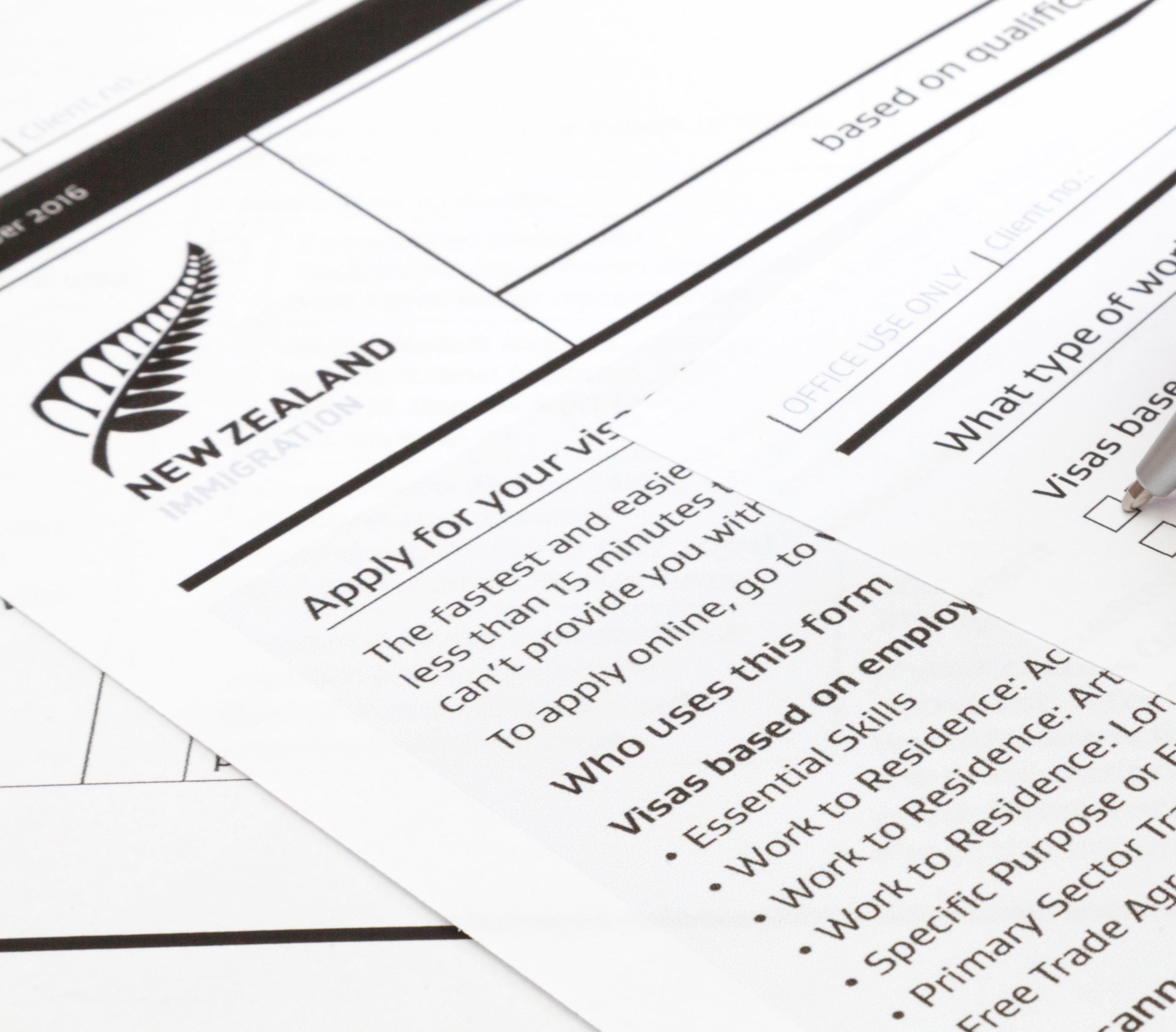
the pay rate sits below the median wage. However, there are important exceptions where it is possible to pay less than the median wage.
We should expect that things will stabilise and we can return to a form of ‘business as usual’, albeit in a tougher environment.
The sector agreements for certain specified roles within the care, construction and infrastructure, meat processing, seafood processing and seasonal snow and adventure tourism sectors provide time-limited relief from the median wage. In most cases, these pay rates now sit at around $26.69 per hour, and the sector agreements are expected to be in place through until 2024. The intention is to allow employers in these sectors time to gradually work towards transitioning to the full median wage where they need to recruit migrant workers.
A further exception to paying the median wage is for specified roles in the tourism and hospitality sector, where a pay rate of $25 per hour is acceptable. It is important to note that this pay rate will increase in April 2023 to $28.18 per hour; so right now there is a time-limited
opportunity for employers to secure work visas for employees in these roles to lock in the current pay rate.

Immigration
New Zealand processing times have blown out to never seen before levels, bringing further pain to both employers and migrants trying to navigate the process.
Visas issued based on pay rates below the median wage are for a maximum two-year duration. They will then require the migrant worker to depart New Zealand and stand down offshore for a minimum of 12 months before they can reapply for a visa at below the median wage.
What does 2023 have in store?
The introduction of the Accredited Employer Work Visa in 2022 brought with it multiple changes

to the immigration system, both at an eligibility level and in relation to the way applications are made and processed. Additionally, Immigration New Zealand processing times have blown out to never seen before levels, bringing further pain to both employers and migrants trying to navigate the process. However, with all that change under our belts and a good working knowledge of how the new system works, we should expect that things will stabilise and we can return to a form of “business as usual”, albeit in a tougher environment. Even if the processing times don’t improve, we are all now better placed to manage the expectations of our internal and external stakeholders, knowing that the timeframes could be lengthy. These matters should give employers some reassurance that things can improve from here.
The recent changes highlighted above indicate the government is responding (albeit in a limited way) to employer feedback. However,
even more promising is the hope that, with a new prime minister and as we draw closer to the election, we may well see moves to further improve the immigration outcomes for New Zealand employers with some easing of the system from the current government, a potential new government, or both. Roll on the rest of 2023!


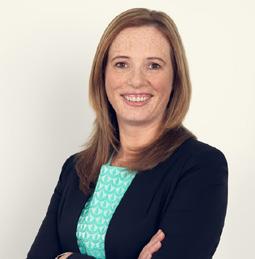
Rachael Mason is qualified in New Zealand, England and Wales, and has practised exclusively in the area of immigration law for several years. Rachael is a facilitator for HRNZ PD courses, virtual courses and webinars. Go to hrnz.org.nz/pd to see upcoming courses. She works with both multi-national corporate clients and smaller local employers across a range of industry sectors in managing their global and local migrant workforces and developing and maintaining compliance and legal right to work policies. Rachael is focused on providing highquality technical immigration advice that is both pragmatic and commercial.


senior management team. Thanks go to Resilient Organisations and Dr Bernard Walker from the University of Canterbury for permission to republish material from its Staffed or Stuffed guide
What if? Asking questions can highlight where the business is most vulnerable to disaster. Consider the following, for example.
• Who is critical to the business? What would happen if they stopped working tomorrow? Create a backup plan.
In the wake of a crisis or natural disaster, it can be difficult for organisations and their employees to recover and rebuild. Despite the devastating effects of a crisis (whether it’s man-made or from external events outside of the organisation’s control), there are ways to recover quickly. Managing in disasters is about protecting the people and the business. The more we support our people, the quicker we can get the business up and running again.
Resilient Organisations, a research and consulting group specialising in organisational risk and resilience, groups the stages of looking after staff in a major disaster as follows:
• planning for your people (before the crisis strikes)
• responding to the situation (after disaster strikes)
• rebuilding a better future
• leadership is essential in all stages of a disaster.
Let’s take a look at each one in turn. This article can be an excellent tool for HR professionals to use to work through any disruptive change with their managers, people leaders and
Start with the basics first and answer these questions.
• What’s relevant to you? Your business location will determine what sort of disasters are more likely to affect you, like flooding in low-level areas or earthquake risk in high-rise buildings.

• What do your staff know? Can your team tell you what they would need to do if a disaster occurred? Talk with them to grow their awareness.
• What do you need to know? What would happen if your business stopped operating – for you, your team and your customers? What do you need to address to keep the business going?
• Disaster communications. How will you check if people are okay and tell them when they’re needed for work? Maintain up-to-date staff contact lists.
• Planning sessions. Have team meetings to discuss what would happen in different types of disasters. Develop solutions together with your team.
• Timing. Would a disaster at 9am or 9pm affect you differently? What would you need to do to respond? How could you contact staff?
• Essential services. If electricity, water or telecommunications are disrupted, how will you keep working and keep in touch with your people and customers?
• Working off-site. Could staff work from home if they needed to? What would they need?
• Employment agreements. Will staff be paid if they can’t work due to a disaster? Consider employment agreements and how these situations will be covered.
• Who does what? Allocate roles and responsibilities to people. Make sure they know what is expected of them and what to do.
Planning and preparations: Your plans are useless if people don't know about them or don't use them.
• Share it. Make sure that all staff know the plan and are part of making it work. Review and discuss it regularly.
• Develop it. No plan is perfect, so consider testing it with drills and scenarios.
• Drop it. In a disaster, you may need to drop the plan and come up with new strategies, depending on the situation. Include this in planning exercises.
• At home? Are your staff prepared at home? Do they have emergency supplies?
Responding to the disaster
Assess the situation. Disasters can be devastating for some people, while leaving others unaffected.

• Changing staff needs. Tangible assistance like food and water may be crucial at first, but later on, social and emotional support may be more useful.
• Returning to work. Some people will want to keep working while others will need to work part-time or take time out. Some people’s workloads may increase while others get less work – monitor this and be ready to adjust workloads. Ensure that both you and your team take time out to rest and recover.
• Listen to suggestions. Team members may provide ideas like sharing jobs or working from home. Be open to exploring ideas that work for everyone.
• Give them control. Allowing staff to share tasks and workloads and shape work around personal situations will help reduce stress and burnout.
How can you support your people? Do what you can. If you can’t help directly, assist staff to access the support they need.
• How’s it going? Check how your people and their families are coping and help if possible. They may initially say they’re fine if they feel others are worse off.
• Okay at first. People who didn’t initially ask for help may need it later on as they become stressed or exhausted dealing with the longer-term effects of the disaster. Keep an eye on your team’s wellbeing.
• Work tools. Ensuring people have the equipment, workspace and tools to do their jobs following a disaster will help reduce stress and frustration.
• Group support. When there is time, hold events for the team to catch up with each other. This will help relieve stress and boost morale.
Listening and communication: Your people will feel more secure if they know what is going on. Be open, honest and listen for feedback.
• Business updates. Provide regular updates like building safety reports, how the business is doing financially, or staffing decisions.
• Assistance. Discuss issues like what type of assistance is available through the business, how long it will continue, and
how to access other services and support in the community.
• Staff needs. People will have an ongoing need to maintain contact with friends, family and insurers while at work. Supporting this will help reduce stress.
• Listening and feedback. Listen to staff feedback and their reactions to decisions. Observe their emotions and feelings, then respond to feedback.
Being flexible and adaptable: Postdisaster will be a challenging time for many. Work together and find ways of moving forward.
Recovering can be the toughest. You will need to reflect back as well as look ahead and move forward.
Lessons learnt: When the business starts to get back into a routine, think about what you and your people have learnt.
• Integrate lessons. Did you create new ways of working during the disaster that worked well and could be integrated into everyday business?
• For future disasters. Review and identify what worked and what didn’t. What would you do differently next time?
• Record. Document the systems you set up so that you can refer back to them in future.
• Knowledge sharing. As new team members join the organisation, share your experiences, make them ready for disasters and involve them in the ongoing planning.
Reflect and recognise: Your people will have worked hard in difficult conditions. Show your appreciation.
• Time out. Take some time to acknowledge what teams have been through, and to share stories. It is an integral part of moving on.
• Acknowledgment. Thank those who supported the business and their teammates. Show that their efforts are appreciated.
• Have some fun. Social events provide opportunities to thank staff and their families for supporting the business.
• Keep them motivated. Being people-focused will help ensure that your team stay motivated and continue to help support the business.
Support and the ‘new normal’: The emotional stress can remain long after the business reopens.
• Long-term stress. Some staff will face ongoing issues like insurance claims, while others will want to move on. Show patience and flexibility.
• Workloads. People will each recover at different rates. Can work be redistributed to allow for staff who need more time out?
• Work–life balance. Encourage staff to take time off with friends and family as work returns to normal. This is important for stress recovery.
• Respect. For some people, things will never be the same. Encourage mutual understanding and respect for those who have experienced traumatic events.
• New environment. Recognise that returning to business as usual may be unrealistic following a major disaster. Assess and adapt to the new environment.

Your people will be watching what you say and do. Make sure that your actions match your words.
Culture: Be a business that values the safety and wellbeing of its people.
• Role model. Show a constant interest and concern for your people. Encourage your staff to do the same for each other.
• Get involved. Organise disaster planning activities to encourage staff involvement.
• Don’t ignore it. When you see a problem, make sure it’s everyone’s job to help fix it. Work together to build a better, safer business.
• Be there. Encourage managers to be on hand to chat with their teams and ask how they are. Just being ‘around’ shows that they care and are involved.
Communicate, communicate, communicate: Talk with your staff regularly and be visible.

• Be active. You need to be constantly initiating communication. Don’t just wait for people to come to you. Show that you care.
• Face-to-face. Consider how you communicate with your team. Face-to-face is often best, especially when issues affect staff personally.
• Active listening. Be open to suggestions and feedback. Are you seen as a person who will genuinely listen?
• Through actions. Don’t just rely on words to communicate with your people. Lead by example to show the behaviours you want to see from them. Be aware: The situation will constantly change.
• Different needs. Both you and your people will have different requirements that will

change over time. Work with the team to find solutions that work for everyone.
• Are you okay? Be aware of your own stress reactions and address them. Buddy systems and time out can help. Be a role model for self-care.
• Are they okay? Look out for signs that your people are upset or distressed. Find out what’s wrong and help as and where possible.
• Leaving. Some staff will want to resign or relocate following a disaster. Be constructive and work with them. They may wish to return later on.
Making decisions: How well you make decisions can make all the difference.
• People first. Your people should always be a top priority when making decisions.
• Quick choices. Decisions may need to be made quickly with little information. Update decisions as you learn more and receive feedback.

• Get support. Know when to ask for advice or help. Having experienced advisors you can call or talk to can be useful.


• But why? Once a decision has been made, let your people know. Explain why you made that choice. The WHY is critical to understanding.
For more resources on what to do at times of natural disaster or a state of emergency, visit the HRNZ website for helpful guides and tips.

Resilient Organisations is a research and consulting organisation based in New Zealand. It has been researching what makes organisations resilient to crises since 2004.








reasonable” standards required by employment law will continue to apply.
Businesses do not tend to thrive through financial downturns, or even worse, recessions. Hard decisions need to be made; efficiencies need to be found, changes or redundancies may be required.
Often these hard decisions are made in circumstances where managers are trying to work out what is around the corner: how long will this downturn last, will our customers stay with us, or will they be making changes, too?
Perhaps we have been through the most challenging circumstances we are ever likely to see for generations: the global COVID-19 pandemic, our international borders closed and national and regional lockdowns being imposed.
No matter how challenging the circumstances, the recent decision of the Employment Court of Drivesure Limited v McQuillan and Ors confirms that the usual “fair and
Drivesure provides vehicle testing services at various sites. It had a contract with the Penrose Compliance Centre (PCC) to carry out such services at its site. That contract was unexpectedly terminated by a letter dated 6 March 2020, effective from 8 May 2020. Mr McQuillan and two other defendants were employed by Drivesure at the PCC site. The case involves a restructuring that ran into the nationwide lockdown in March and April 2020.
Drivesure unsuccessfully attempted to get PCC to reconsider terminating the contract. On 10 March, Drivesure advised the defendants of the termination of the contract with PCC. In letters dated 17 March, Drivesure wrote to each of the defendants proposing that all the positions at PCC would be made redundant. Drivesure said it had considered redeployment to other sites, but that was not possible.
Drivesure wanted to meet with the defendants to receive feedback on the proposal, with a meeting suggested to take place on 24 March 2020. There was some correspondence between Drivesure
and the defendants after the letter of 17 March, including a request from Mr McQuillan to postpone the meeting until 26 March because his legal advisor was busy. Drivesure was not prepared to defer the meeting but offered to meet any time before then, including before work and in the evening.
Circumstances intervened, and on 23 March 2020, the Prime Minister announced that New Zealand was immediately moving to Alert Level 3 under the Government Alert Level Framework and would move to a strict Alert Level 4 lockdown two days later. It was after that announcement that Drivesure said it intended to make a decision on the redundancy proposal by 25 March 2020.
The defendants sent an email on 23 March 2020, and again the following morning, outlining why they could not meet, including their frames of mind, health and safety reasons for meeting in person, and their legal advisers being unavailable.
Drivesure considered that, because of the lockdown, it was critical to act quickly to preserve the whole Drivesure business. Drivesure responded to the defendants on 24 March, saying that if the

defendants did not wish to meet that day, then they were to provide any further feedback on the proposal in writing by 25 March 2020, after which Drivesure would consider all feedback received and make a decision. Each of the defendants responded in different ways.
• Mr McQuillan asked questions about the selection process for staff and asked to attend mediation.
• Mr Raj questioned the rationale for the proposed redundancy and questioned that PCC was his fixed site.
• Mr Rafiq thought the decision was unfair, having regard to his history and experience with Drivesure. He offered to make changes, including changing his workplace
to another site, reducing his working hours or days, or helping out in other areas of the business.




On 25 March 2020, Drivesure emailed each of the defendants advising that the proposal would go ahead and their employment would be terminated.
Judge Holden found that, even taking account of the circumstances Drivesure was facing, the last part of the process was unduly rushed. It was not a process that was open to a fair and reasonable employer in all the circumstances.


The Court found no reason to reduce the relatively modest compensation awarded by the Employment Relations Authority of $8,000 for each of the defendants.
Interestingly, the case was argued on the basis of unjustified disadvantages rather than unjustified dismissals. The process was successfully challenged, but the substantive reasons for the redundancies were not challenged. Drivesure Limited v McQuillan and Ors [2022] NZEmpC 176
David Burton is an employment law barrister. David has over 30 years of employment law experience in New Zealand and overseas. His expertise is recognised by his peers. For six years, he was appointed to the Employment Law Committee of the New Zealand Law Society. Before that, he served on the Workplace Relations and Employment Law Sub-committee of the Law Institute of Victoria, Australia. For more info, visit www.burtonlaw.co.nz or email david.burton@burtonlaw.co.nz
We’re no doubt living in a time where burnout, self-doubt and feeling overwhelmed are at an all-time high. Tash Pieterse looks at what’s going to make the difference if HR professionals want to thrive and succeed.

The world has been through the most challenging times, at least in my recent memory, and professionals are feeling it. Especially HR professionals who need to support employees and somehow support themselves, too. This is why I created the increasingly impactful and successful coaching programme Thriving HR Professionals (THRP) as part of the HRNZ professional development offering. The key to thriving and making it through the next few years is three-fold.
Knowing yourself, who you are, what you value, what you stand for, and what helps you to be your best is the foundation for navigating through uncertainty and change. It’s easy to get caught up in the overwhelming inputs from the outside, but when you’re clear on who you are and the value that you have to offer both personally and professionally, you will thrive confidently and securely. The THRP sessions start with an in-depth reflection and creation piece on solidifying who you are and who you really want to be. Your uniqueness is what will make you successful (whatever that is for you).
Your mindset is how you see, interact with and respond to the world. It’s how you move through your experiences and defines how those experiences affect you. When you can wire your mindset to come from a growth approach, it will fundamentally shift the way you move through change, uncertainty and fear. It will allow you to see that nothing is finite, concrete or black and white. It will allow you to be open, creative
and adaptive to what’s coming your way, which in turn helps you to take action, make decisions and essentially build confidence. Mindset is at the core of THRP, and it is at the heart of creating sustainable success.
Thriving
Professionals sessions start with an in-depth reflection and creation piece on solidifying who you are and who you really want to be.
Boundaries are what maintain your energy stores and knowing where you end and others begin. Burnout, anxiety (fear and worry) and feeling overwhelmed are at an all-time high, and often occur because of poor (or lack of) supportive boundaries. In THRP, participants do a complete energy audit. They get crystal clear on where their energy is leaking so they know where boundaries are needed to best support what and how they can give and ensure they are always working and delivering from a full cup, which benefits everyone. When you look after yourself, others are looked after in return.
When you can wire your mindset to come from a growth approach, it will fundamentally shift the way you move through change, uncertainty and fear.HR
These three elements are the foundations for creating a life and career where you can truly feel successful and like you’re thriving each and every day. When these are practised consistently, you can’t help but feel and be your best for yourself and those around you.

It’s essential for you to take ownership of yourself, your success, your mindset and your wellbeing. When you do that, nothing will stand in your way. Not even the most significant of uncertainties and change will have you feeling completely lost and depleted. You will always have what it takes to tackle what comes your way. When you look after yourself, others are looked after in return.
Tash Pieterse is an internationally certified and award-nominated leadership and mindset coach, leader and mother. She works with ambitious individuals and courageous leaders to empower them to become the best version of themselves, so they can confidently set themselves and their teams up for success. She teaches and coaches her signature Thriving HR Professionals as part of the HRNZ professional development programme. Bookings can be made on the HRNZ website





was experienced in adopting and using online tools like MS Teams and Zoom, which may be unprecedented in the history of the workplace. Empathetic approaches by managers, correct work station set-ups, flexibility and social connections through virtual tools all played a crucial part in supporting employees to adapt to the new way of working.
and Jain, 2021). Additionally, remote work has enabled employees to work from anywhere, opening up opportunities for a more diverse and inclusive workforce.
The COVID-19 pandemic has led to a massive shift in the way people work, including the prevalence of remote working. This has resulted in numerous challenges and opportunities for both employees and employers and has the potential to bring about profound implications for the future of work. This article is based on our qualitative research conducted in 2020–21 in New Zealand to explore the experiences and perceptions of knowledge workers working from home during the pandemic.
The study found that, through the lockdown period, virtual tools became a go-to mechanism for individuals and teams working remotely to collaborate and coordinate. A quick learning curve
Participants reported a host of challenges, such as managing work–life balance, ensuring productivity and maintaining mental health. Employees have had to juggle work responsibilities with family obligations, including caring for children and elderly parents. Increased stress and anxiety associated with COVID-19 uncertainties and adjusting to pandemic-imposed working from home (WFH) was experienced. WFH also raised concerns about the challenges with technology, lack of visibility and the social aspect of the office environment (Jain and Choudhary, 2022).
However, respondents also realised the benefits of working from home. For example, employees save time and money on commuting, resulting in a better work–life balance. It enables better focus and greater productivity on tasks requiring a quiet environment (Choudhary
The pandemic has accelerated the trend of remote work. Therefore organisations must re-evaluate how they approach their work arrangements. Here are a few ways in which the future of work is likely to be affected.

1. Flexible working arrangements
Employees are showing an inclination for employers who provide flexible working arrangements, and many companies are considering various options for flexible work policies. This could mean that employees can work from home a few days a week or work flexible hours. With the realisation that WFH often tends to foster isolation and lack of in-person connectedness, there is a greater preference for hybrid working, which helps build a sense of community and connection within the workplace, keeping the organisational culture alive. Flexible working arrangements can also provide
employees with more autonomy over their work, which is essential for employee motivation and engagement.




The pandemic has highlighted the need for better remote work infrastructure, including faster internet speeds and improved collaboration tools. Investing in remote work infrastructure will be essential to ensure remote workers have access to high-quality technology to maintain their productivity and engagement levels. By investing in more flexible offices designed to accommodate employees who come into the office occasionally, organisations can reduce their overheads.
3. Reinforce health and safety

With the move to employees working from home, there needs to be a check for whether employees are aware of and following health and safety requirements and regulations, including ergonomic WFH set-ups, as well as employees incorporating rest and breaks in between work times.
4. Inclusive and diverse workforce
Remote and flexible working can bring opportunities to hire

from an expanded talent pool, resulting in a more diverse and inclusive workforce. This can bring new perspectives, ideas and approaches, which will help companies to innovate and respond to changing demands more effectively.
In conclusion, working from home during the pandemic has presented both opportunities and challenges for employees and employers. Employees need to be self-motivated and disciplined and able to manage their time effectively. They also need to be proficient in using remote work tools and technologies. As we move forward, it is crucial for companies to address the challenges of remote work and to provide employees with the necessary support and infrastructure to work effectively from home.
References
Choudhary, N and Jain, S (2021). An exploratory study on knowledge workers’ perceptions and experiences of working from home posed by Covid-19 pandemic in New Zealand, 34th Annual Australian & New Zealand Academy of Management (ANZAM) Conference Proceedings. www. anzam.org/wp-content/ uploads/2022/03/8038ANZAMPapers-and-AbstractsConference-Solutions_DEC2021_V3.pdf
Jain, S and Choudhary, N (2022). Working from Home and Resilience among Working Parents During Covid-19. In E Papoutsaki and M Shannon (eds), Proceedings: 2021 ITP Research Symposium, 25 and 26 November (pp 153–168). Auckland: ePress, Unitec, Te Pūkenga. doi. org/10.34074/proc.2205012

Dr Neeru Choudhary is Senior Lecturer, Business and Enterprise at the Open Polytechnic of New Zealand | Te Pūkenga. She holds a PhD in business management and has over 15 years of experience in teaching various management courses at undergraduate and post-graduate level. Her research interests are flexible work arrangements, online education, leadership, motivation and employee engagement.

Dr Shilpa Jain is Senior Lecturer in Business and Enterprise at the Open Polytechnic of New Zealand | Te Pūkenga. She holds a PhD in Business Management, a Masters in Management Studies and has substantial teaching experience at master’s and undergraduate level at tertiary institutions in India, United Arab Emirates and New Zealand. Her research interests are in the areas of workplace stress and job burnout, flexible work arrangements, work teams and business sustainability.

through leadership development work I had undertaken. I decided to invest in development that involved various forms of psychometric profiling, working with a behavioural psychologist and an executive coach, and including 360-degree feedback on how I showed up as a leader at MAS.
you won’t get there at all. It will remain a dream with a fair chunk of frustration left in your team as a result.
My daughter is turning 16. How time flies. She’s incredibly practical, but, like a lot of teenagers, she has big ideas of what her life might be like as she leaves school and enters the next phase of her life. Recently, she talked my wife and me through her grand vision of living abroad while studying at one of Europe’s renowned universities. A noble ideal. Sounded amazing. However, after a few questions from us, she was off to research acceptance rates at said universities, tuition costs, accommodation options, the cost of airfares, and immigration requirements.
Her latest plan is a gap year followed by attendance at one of our own fine establishments here in Aotearoa, flatting with people she knows. And a possible semester spent overseas at some point during her studies. As I mentioned, incredibly practical and clever.
This exchange caused me to reflect on something I’d learned recently
As part of the 360-degree process, one of my direct reports gave me some great and courageous feedback, and, equally courageously, she unpacked it for me in a catch-up later on. It felt like such a no-brainer, but it was such an ‘a-ha moment’ for me.
Now, if you know me, I’m a big picture, set a vision, capture hearts and minds kind of guy. Her feedback to me was something along the lines of “Mike, we love the vision you set for us as a team. We feel part of it, and we get excited by what we can do at MAS. But we have no idea how to get there. How do we get from where we are today to that vision you’ve painted for us?”. Boom, simple stuff, right?

It’s so easy for leaders and managers to forget that every journey begins with the very next steps. A big, hairy, future-focused dream or vision is great, but if you can’t outline the course changes necessary right now to steer the ship there, chances are



And, once you’ve sat back and planned the first steps to your vision, you might also get a chance to course-correct, much like my daughter did. Nothing wrong with being practical.


2023 Pulse of Talent Report Australia and New Zealand


